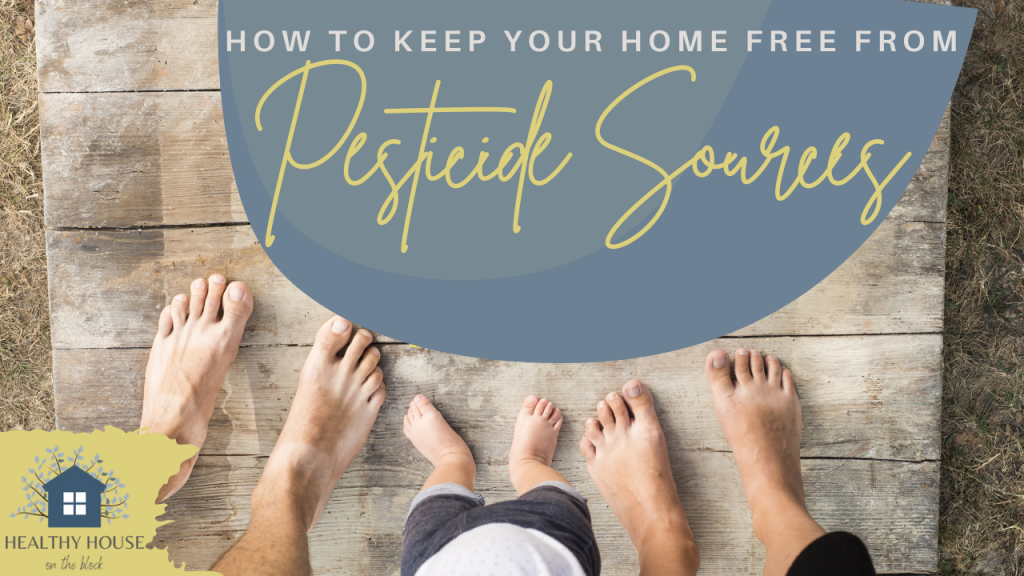
Pesticides have become a regular part of life in our farming and gardening practices. As with many tactics, products and solutions we’ve been using for years and years in the United States, we’re finding loopholes in the solution. What was once just a way to preserve the hard work of farmers has turned into a very serious health concern affecting more households than we realized. Natural pesticides and organic pesticides are great alternatives, but that’s probably a change you can only make in your own home. There are more pesticides coming in on our food, in our clothes and in our furniture than most of us realize.
When I sat down to look at the sources of pesticides that we allow to enter our homes, I was surprised and a little taken back to discover that pesticides were more a part of my indoor living environment than I cared to admit. And the most common sources were ones that I really wasn’t that aware of. Sure I know to use natural pesticides and organic pesticides when treating my own plants and garden. But what about all the plant based materials and items that I have in my home? I hadn’t considered those when I first delved into this research.
If you’re looking to reduce toxins and toxin exposure that happens in your home, pesticides are a huge source that you could reduce and work on eliminating. The best way I know to start when looking to create a healthier home environment is by understanding the toxin you’re trying to reduce. Here’s what we’ll look at in terms of pesticides:
- What even are pesticides?
- The health effects of pesticide exposure
- The numerous sources of pesticides in your home
- How you can reduce pesticides in your home
- Options for organic pesticides and natural pesticides for your own plants and garden
WHAT ARE PESTICIDES
What exactly is a pesticide? Pesticides in and of themselves, are not a bad thing. A pesticide is any substance that is intended for preventing, destroying, repelling or mitigating any pest. This means you could use something totally natural and organic and still be using a form of pesticide. Pesticides also include insecticides, herbicides and fungicides.
Most pesticides are created to be extremely resilient. Often pesticides are made with ingredients that are resistant to UV rays, meaning they don’t break down easily. This means that pesticides have a very long life and can be left on food we eat, clothing we wear and wood products we bring into our homes. Pesticides contain chemicals that are used to attach the nervous system of the insects, causing them to die.
Pesticides are used in almost all farming practices, from our produce and food to our clothing and textiles. Pesticides are even used to treat wood products that we bring in our home. To be honest, when I started to look at where pesticides were in my home, it began to feel overwhelming; because I saw they were in a LOT of different places.
A pesticide product that you purchase at the store will usually only list the active ingredient, however there are also inert ingredients within the product as well. These inert ingredients can make up 95% of the product, yet we won’t be privy to what those ingredients are.
But I think it’s worth mentioning that ANY solution that is intended to get rid of or repel insects, funguses or weeds is in fact a pesticide. AND, what’s more is that even if you’re using a totally natural solution to do this, it doesn’t always mean it’s safe for humans to be exposed to constantly.
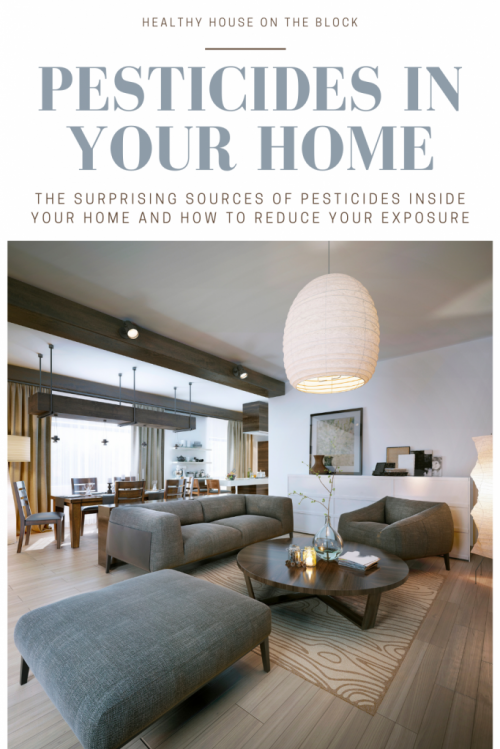
HEALTH EFFECTS OF PESTICIDE EXPOSURE
I think one of the biggest problems with pesticides is that we are exposed and in contact with pesticides in a variety of forms and at a variety of times throughout our day. The three main ways we are exposed to toxins is through our food, on our skin and in the air we breathe. Pesticides check all three of these boxes just inside our homes.
This means that not only are we exposed in a variety of ways, we’re also being overloaded by pesticides through continuous exposure. Children are at an even bigger risk for exposure because the ingest toxic chemicals that are in dust and soil more than adults. This is due primarily to their hand to mouth habits. But it’s because children ages 1-4 spend an average of more than 20 hours a day indoors and most of that time, on the floor. (Source)
A national study from 2010 showed that children ages 8-15 were almost twice as likely to be diagnosed with ADHD when pesticides were detected in their urine samples.

Another published study from 1998 linked children with pesticide exposure to an increased risk of childhood cancer. This study followed exposures that happened in homes, schools, through drinking water and food.
In men, pesticides have been shown to decrease the quality and mobility of sperm and also contributed to altered reproductive and endocrine function. This study from 2008 also points to general fertility issues in men who are exposed to pesticides. The study does account for men who generally apply pesticides, and does not necessarily address constant home exposures.
Women, and specifically pregnant women, are the groups of greatest concern. Because insecticides are created to attack the nervous system, first trimester exposure (when the nervous system is rapidly developing in a baby), is a time period of great concern as discussed in this 2004 published journal. Pesticides have been linked to increased risk of developmental defects and stillbirths (2006 Journal for Reproductive Biology and Endocrinology)
In women, pesticides have been shown to disrupt the hormonal function of the reproductive system as well as the ovarian cycle. It has also been shown to disrupt the thyroid function and inhibit the central nervous system. (2006 Journal for Reproductive Biology and Endocrinology)
A control study done in 2008 also linked pesticide exposure to an increased risk of Parkinson’s Disease. Another published study in 2006 also linked long term exposure to developing Parkinson’s Disease as well.
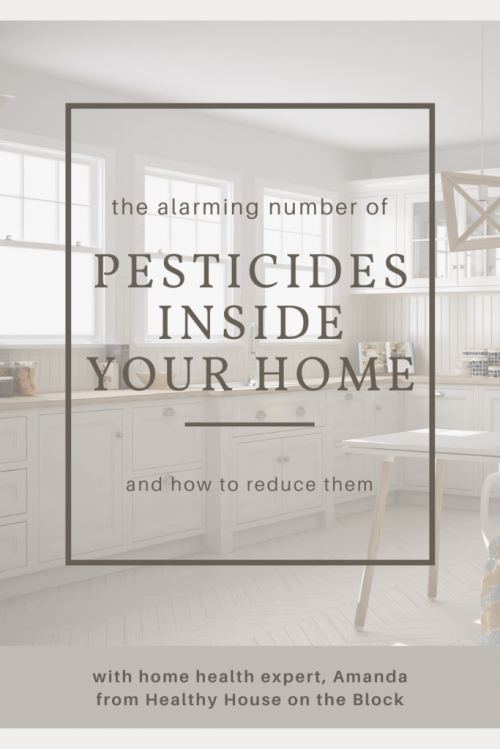
SOURCES OF PESTICIDES IN YOUR HOME
Drinking Water: The University of Missouri published a page all about pesticides and the environment,and more specifically about how pesticides can get into our water sources through runoff and leaching in the soil. Drinking water is a HUGE source of pesticides in many areas of the country. I recommend having your home’s water tested with TapScore to ensure pesticides are not present.
Cotton: Another farming industry that uses a large amount of pesticides is the cotton farming industry. BT Cotton is a type of cotton that was created and genetically altered to be more resilient to pests, insects and fungus while being grown. Because this type of plant is genetically modified, it actually produces toxins as it grows. (STUDY). Unfortunately, we truly have no idea if our cotton textiles are made from pesticide treated cotton, naturally grown cotton or BT cotton. But it’s safe to assume MOST of our textiles are probably made with BT Cotton as there are over 70 million acres of it growing across the world. (INFO)
Produce: Pesticides are commonly used in farming practices related to growing food. Residues from pesticides can be found in most of our everyday foods from beverages to produce to the feed given to animals we then process for meat (STUDY). Pesticides have been detected inhuman breast milk samples as well as in urine samples, meaning it is an almost constant exposure.

House Dust: Almost all house dust contains some levels of insecticides and pesticides, as shown in this 2006 study. This published article from 2003 also showed that there was increased dietary exposure to pesticides due to the transfer of pesticides from household flooring to surface foods. This was more of an issue with children, but the transfer did pertain to all family members.
Pesticide Use In Home: Using a spray to kill or prevent bugs of any kind can directly impact your indoor air quality and the health of your indoor environment. Not only are you adding the pesticides to your home’s sufrances, but there is a significant amount of overspray and surface transferring that can happen after the initial use of the pesticide.
REDUCING PESTICIDE EXPOSURE AT HOME (PLUS AN ORGANIC PESTICIDE OPTION FOR BUGS AND PLANTS)
Filter Your Water: Pesticides can enter water through runoff and soil leaching. I recommend every home have a water filter for drinking water, especially if you live in a rural area. If you want a countertop option, I like the Berkey Filter. You can also get a reverse osmosis system for your home, which will remove pesticides from the water. Be sure to check out my Healthy Water Workbook for more on your drinking water.
Dust Often: Pesticides were found in many homes across the country, and it was all attributed to pesticides in house dust. Keeping up on your dust removal efforts can help eliminate and reduce pesticide exposure at home through dust. This is especially true if you have kids. Kids ingest more dust than adults because their hands are in their mouths more often and they spend more time on the floor. This post about dusting and dusting spray can help you get started.
No Shoe Policy: Because a large portion of environmental pesticide exposure comes from our shoes, it’s a good idea to start a no-shoe policy and create a functional entry space to keep shoes out of your living spaces. This blog post about healthy entryway ideas will help guide you on just how to keep shoes out of your house to prevent pesticide exposure.
Organic Pesticides for Bugs & Pests: If you do need to use a pest control in your home (which, let’s face it, we all do at one time or another), then make sure you’re using an organic, natural bug repellent. EarthKind Stay Away is my favorite all natural solution to pest control in my home. I’ve used it for the past year and been MORE than happy with it’s organic pesticide formula and how well it works. (You can read more in this blog post about natural bug repellent at home)
Organic Pesticides for Plants: Plants can be an excellent addition to our indoor spaces. But if plants are treated with pesticides to keep them healthy, they in turn aren’t keeping us very healthy. The good news is you can use a organic pesticide, natural option for homemade fertilizer and homemade pest and weed control. With this approach your plants will truly benefit your space.
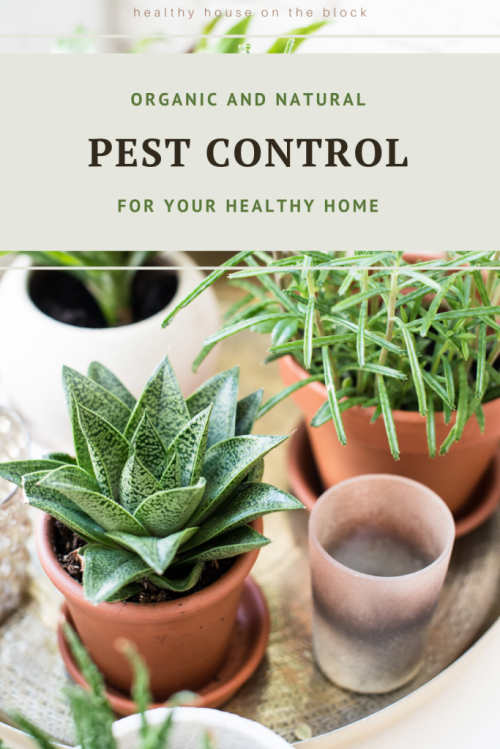
Buy Organic Produce: Ingesting foods that have been treated with pesticides is one of the biggest exposures to pesticides most of us will experience. By purchasing organic produce and looking for USDA Certified Organic food products, you can reduce exposure drastically. Our family likes to shop Thrive Market when looking for USDA Certified Organic foods.
Purchase Organic Cotton Clothing and Textiles: Finding organic cotton is the key to limiting exposure through skin absorption. At the same time, you can also address your textiles,bedding and towels to ensure that they are also an organic cotton, or other organic natural fiber.
This post about organic bedding and this post about organic baby blanket and bedding can be helpful as a place to start.
Air Purifer: Pesticides often come in on our shoes and stick around in our dust. With a True HEPA filter, you can filter practically all particles that are left in your home, including pesticides attached to your dust and dirt.
MedifyAir is my air purifier of choice and they’ve given me a coupon for $15 off their purifiers (just use code HHOTB15 at checkout)
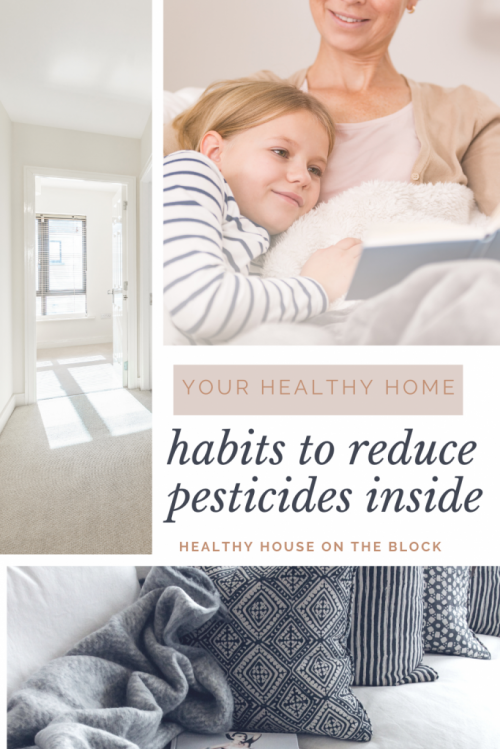
Although I found that there were way more sources of pesticides than I originally thought, I’m so happy to find out that reducing pesticides indoors saw an immediate reduction in exposure. I think by switching from the way we’re currently treating pests to a more natural method, we can also see a nationwide benefit. I’m going to continue to use organic pesticide products and methods to reduce my exposure and my family’s exposure.
Share this:
- Click to share on Facebook (Opens in new window) Facebook
- Click to share on LinkedIn (Opens in new window) LinkedIn
- Click to share on Reddit (Opens in new window) Reddit
- Click to share on Pinterest (Opens in new window) Pinterest
- Click to print (Opens in new window) Print
- Click to share on X (Opens in new window) X




Pingback: Organic Bath Towels, Kitchen Towels & Turkish Towels »
Pingback: Natural and Organic Bedding Guide » Healthy House on the Block
Pingback: Healthy Homes Create Healthy Kids
Pingback: Best Organic Pillow for a Healthy Bedroom - Healthy House on the Block